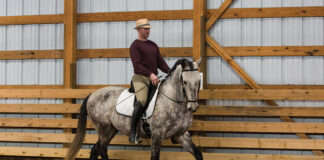In developing solutions for horse training problems, it’s important to look at things from the horse’s point of view. If your horse is particularly lazy and unmotivated in the arena, even if he is fine on the trail and at shows, this is a sign that he is trying to tell you something. Horses try to communicate with us, and being able to understand where they’re coming from will play a major role in solving issues such as laziness, stubbornness, and resistance in the arena.

Just like people, horses have different personalities, which we call “Horsenalities.” Knowing your horse’s Horsenality will open up a world of understanding for you.
Usually a horse that lacks motivation to move is a “left-brained” horse that is more inclined to challenge you and argue. He is also introverted, which, for a horse, means that he does not want to move his feet. So, in Horsenality terminology, this horse is a Left-Brain Introvert.
Sensitizing Your Horse
Instead of spurring and spanking the unmotivated horse, you will get much better results if you can think about what the horse needs in order to find more joy and motivation inside the arena. We suggest you start on the ground, because this is the best place to teach your horse a new concept. Begin by teaching him to respond to light pressure when you ask him to back up.
Standing in front of your horse, put your hand on the snap of the lead rope and slowly push it away from you to ask your horse to back up.
If he doesn’t move, or is heavy and reluctant, keep the pressure the same (don’t increase it) and tap him lightly with the stick on each leg (below the knee) until he lightens up in the halter; then release the pressure immediately. By starting softly and releasing quickly, you will sensitize your horse to the message. If you are heavy-handed and slow to release, you’ll make your horse dull.
Wait until he sighs or licks his lips. This will let you know that he’s processing what he learned. Repeat. You may need to do it a couple of times before he’s sure.
When he understands the concept, ask for three steps, then five, then 10. Any time he pushes on the halter instead of yielding, tap him on the leg. With practice, you’ll find you won’t even need the stick—and eventually, the halter and lead—at all. As your horse becomes more responsive to your cues, you will develop a mental and emotional bond that’s stronger and more effective than any lead rope.
In the saddle, try this: Engage your seat and lightly close your legs.
Give him a couple of seconds to respond without increasing your aids. If he doesn’t, use your stick and tap him on the flat of his shoulder in front of your saddle.
The moment he tries to move forward, release the pressure of your legs and seat, and rub him.
Repeat until he moves forward with just your seat and a light leg. Remember: the heavier your leg, the more dull your horse will get!
Head toward a destination at the other side of the arena. Your horse has to arrive somewhere, or he’ll lose interest in going.
Don’t worry about how slow it is at first; it will get better as your feel and his understanding improve. Most importantly, don’t keep pressing with your legs.
Keep Your Horse Motivated
When you know what you want and your horse doesn’t do it, it’s easy to get mad or frustrated. But remember that horses really can sense our emotions, both positive and negative. Controlling your emotions is critical to good horsemanship.
Finally, when your horse is lazy, stubborn and dull, it’s likely because he’s bored. Rather than riding endless circles in the arena, you need to keep him thinking and guessing about what’s coming next. Do lots of transitions. Change direction a lot, do random patterns, and learn to do new things. Most of all, remember to reward your horse with rest and scratches. Keep your horse’s motivation in mind, and pretty soon he’ll be happy to go into the arena with you.
Pat and Linda Parelli have dedicated their lives to helping raise the level of horsemanship worldwide for the benefit of horses and the people who love them. Through Pat and Linda’s educational program, hundreds of thousands of horse enthusiasts from around the world have learned how to build solid, communication-based partnerships with their horses. Visit www.parelli.com for more information about Pat, Linda and the Parelli Program.
This article originally appeared in the April 2014 issue of Horse Illustrated magazine. Click here to subscribe!






Going to try the backing up with a young horse I am working with.
Yes, boredom is key.